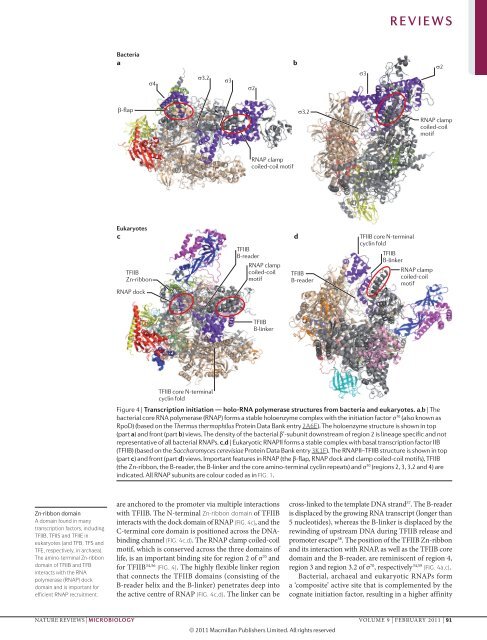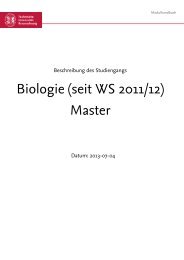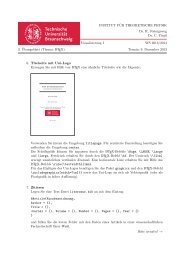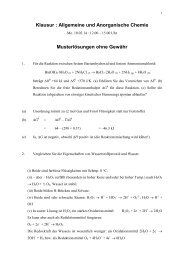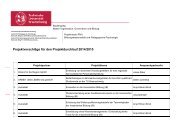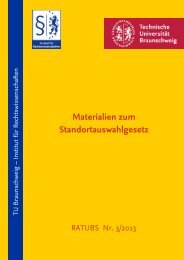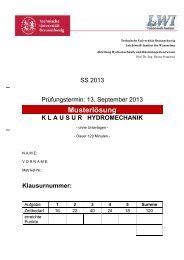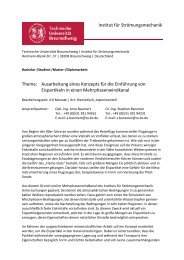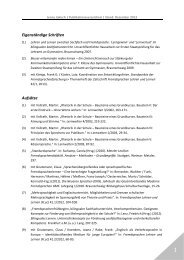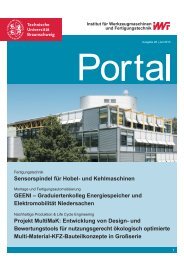L - Technische Universität Braunschweig
L - Technische Universität Braunschweig
L - Technische Universität Braunschweig
You also want an ePaper? Increase the reach of your titles
YUMPU automatically turns print PDFs into web optimized ePapers that Google loves.
REVIEWS<br />
Bacteria<br />
a<br />
σ4<br />
σ3.2<br />
σ3<br />
σ2<br />
b<br />
σ3<br />
σ2<br />
β-flap<br />
σ3.2<br />
RNAP clamp<br />
coiled-coil<br />
motif<br />
RNAP clamp<br />
coiled-coil motif<br />
Eukaryotes<br />
c<br />
TFIIB<br />
Zn-ribbon<br />
RNAP dock<br />
TFIIB<br />
B-reader<br />
RNAP clamp<br />
coiled-coil<br />
motif<br />
d<br />
TFIIB<br />
B-reader<br />
TFIIB core N-terminal<br />
cyclin fold<br />
TFIIB<br />
B-linker<br />
RNAP clamp<br />
coiled-coil<br />
motif<br />
TFIIB<br />
B-linker<br />
TFIIB core N-terminal<br />
cyclin fold<br />
Figure 4 | Transcription initiation — holo-RNA polymerase structures from bacteria and eukaryotes. a,b | The<br />
bacterial core RNA polymerase (RNAP) forms a stable holoenzyme complex with the initiation Nature factor Reviews σ 70 (also | known Microbiology as<br />
RpoD) (based on the Thermus thermophilus Protein Data Bank entry 2A6E). The holoenzyme structure is shown in top<br />
(part a) and front (part b) views. The density of the bacterial β’-subunit downstream of region 2 is lineage specific and not<br />
representative of all bacterial RNAPs. c,d | Eukaryotic RNAPII forms a stable complex with basal transcription factor IIB<br />
(TFIIB) (based on the Saccharomyces cerevisiae Protein Data Bank entry 3K1F). The RNAPII–TFIIB structure is shown in top<br />
(part c) and front (part d) views. Important features in RNAP (the β-flap, RNAP dock and clamp coiled-coil motifs), TFIIB<br />
(the Zn-ribbon, the B‐reader, the B-linker and the core amino‐terminal cyclin repeats) and σ 70 (regions 2, 3, 3.2 and 4) are<br />
indicated. All RNAP subunits are colour coded as in FIG. 1.<br />
Zn-ribbon domain<br />
A domain found in many<br />
transcription factors, including<br />
TFIIB, TFIIS and TFIIE in<br />
eukaryotes (and TFB, TFS and<br />
TFE, respectively, in archaea).<br />
The amino‐terminal Zn-ribbon<br />
domain of TFIIB and TFB<br />
interacts with the RNA<br />
polymerase (RNAP) dock<br />
domain and is important for<br />
efficient RNAP recruitment.<br />
are anchored to the promoter via multiple interactions<br />
with TFIIB. The N‐terminal Zn-ribbon domain of TFIIB<br />
interacts with the dock domain of RNAP (FIG. 4c), and the<br />
C‐terminal core domain is positioned across the DNAbinding<br />
channel (FIG. 4c,d). The RNAP clamp coiled-coil<br />
motif, which is conserved across the three domains of<br />
life, is an important binding site for region 2 of σ 70 and<br />
for TFIIB 34,56 (FIG. 4). The highly flexible linker region<br />
that connects the TFIIB domains (consisting of the<br />
B-reader helix and the B‐linker) penetrates deep into<br />
the active centre of RNAP (FIG. 4c,d). The linker can be<br />
cross-linked to the template DNA strand 57 . The B‐reader<br />
is displaced by the growing RNA transcript (longer than<br />
5 nucleotides), whereas the B‐linker is displaced by the<br />
rewinding of upstream DNA during TFIIB release and<br />
promoter escape 58 . The position of the TFIIB Zn-ribbon<br />
and its interaction with RNAP, as well as the TFIIB core<br />
domain and the B‐reader, are reminiscent of region 4,<br />
region 3 and region 3.2 of σ 70 , respectively 34,59 (FIG. 4a,c).<br />
Bacterial, archaeal and eukaryotic RNAPs form<br />
a ‘composite’ active site that is complemented by the<br />
cognate initiation factor, resulting in a higher affinity<br />
nature reviews | Microbiology Volume 9 | february 2011 | 91<br />
© 2011 Macmillan Publishers Limited. All rights reserved


